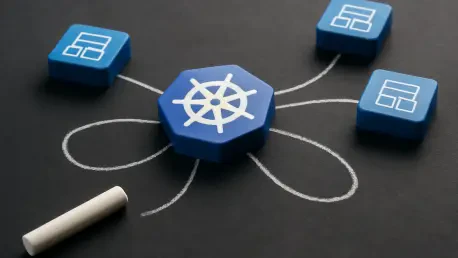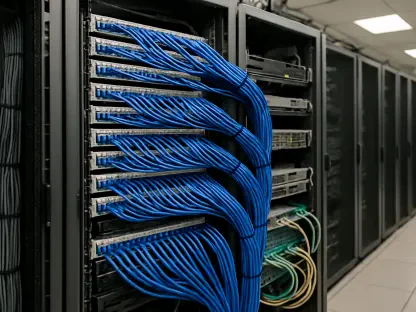A recent global survey has unveiled the intricate and often overwhelming challenges that IT professionals face when managing networking in Kubernetes, the dominant container orchestration platform, with input from 232 participants across various roles. The findings paint a vivid picture of a landscape marked by complexity, tool overload, and a noticeable gap in specialized expertise. This data highlights a critical pain point for organizations relying on Kubernetes to power high-value workloads, from microservices to emerging AI applications. As cloud-native environments continue to expand, the struggle to balance functionality, security, and transparency in networking becomes a pressing concern for teams worldwide. The insights from this comprehensive study serve as a wake-up call, urging a reevaluation of how responsibilities and resources are allocated to tackle these persistent hurdles.
Unpacking the Complexity of Kubernetes Networking
Tool Overload and Fragmentation in Management
The survey reveals a striking reliance on multiple tools, with respondents using an average of 6.28 different solutions to manage Kubernetes networking. This fragmented approach often leads to inefficiencies, as teams juggle disparate systems to handle tasks like debugging and observability, which 61% of participants identified as a top challenge. The use of tools such as Grafana, favored by 75% of respondents, alongside packet visualization and click-to-trace applications, reflects a desperate need for visibility in an otherwise opaque environment. However, this tool-heavy strategy often exacerbates the cognitive load on IT professionals, many of whom are not networking specialists. With only 11% of respondents identifying as network experts, the burden falls on platform engineers and DevOps practitioners to navigate these complexities, diverting attention from other critical tasks in their workflows.
Diverse Environments Adding to the Challenge
Beyond tool fragmentation, the diversity of Kubernetes environments adds another layer of difficulty. A significant 60% of respondents are deeply engaged in networking tasks, managing setups ranging from self-hosted instances to Amazon Elastic Kubernetes Service (EKS), used by 36%. Other platforms, such as Azure Kubernetes Service (AKS) at 27% and Google Kubernetes Engine (GKE) at 22%, further illustrate the varied landscape. Node management scales are equally broad, with 51% handling between 11 and 100 nodes, and 8% overseeing more than 100. This wide range of configurations and platforms demands a high level of adaptability, often without the benefit of specialized networking knowledge. The challenge of connecting these modern clusters to legacy applications remains a persistent issue, highlighting the need for broader skill development to bridge technological gaps in hybrid environments.
Addressing Security and Expertise Gaps
Security Concerns in a High-Stakes Environment
Security emerges as a paramount concern in the survey, with 52% of respondents citing inter-cluster communication as a critical vulnerability. Other pressing issues include enforcing policies across multiple clusters and ensuring multi-tenancy segregation, both noted by 39% of participants. Securing ingress and egress traffic, alongside controlling operator access, also ranks high among worries, as Kubernetes environments often host sensitive workloads like databases and web applications, deployed by 93% of those surveyed. The complexity of maintaining robust security measures while managing high-performance demands under load—flagged by 30%—creates a delicate balancing act. Without streamlined tools or sufficient transparency, organizations risk exposing critical systems to threats, underscoring the urgency of adopting cohesive security strategies tailored to these dynamic setups.
The Expertise Shortfall and Future Shifts
Compounding the security challenges is the limited involvement of networking specialists in Kubernetes management. With only a small fraction of respondents possessing dedicated networking expertise, the responsibility often falls to non-specialists, amplifying the strain on teams. Experts suggest this trend may shift as more clusters move into production, necessitating the integration of specialized skills to handle intricate networking demands. The rise of platform engineering teams, with 43% of respondents identifying as members, points to a potential evolution in collaborative approaches. By distributing the cognitive load more evenly and fostering targeted training, organizations can better prepare for the complexities of connecting modern clusters with legacy systems. This shift toward the inclusion of networking professionals could pave the way for more resilient and efficient Kubernetes environments.
Pathways to Streamlined Networking Solutions
Reflecting on Past Challenges
Looking back, the survey conducted by a Cisco subsidiary offered a detailed glimpse into the state of Kubernetes networking, exposing deep-rooted issues that plagued IT teams. The overwhelming reliance on multiple tools, coupled with significant security vulnerabilities, painted a picture of an industry grappling with rapid growth and insufficient resources. The scarcity of networking specialists at the helm of these operations was a recurring theme, often leaving non-experts to shoulder intricate tasks. From managing diverse environments to securing high-value workloads, the hurdles identified in the findings underscored a critical need for change. These insights captured a moment of reckoning, where the scale of Kubernetes adoption outpaced the readiness of many organizations to address its networking intricacies.
Building Toward Future Resilience
Moving forward, organizations must prioritize strategic solutions to overcome the networking struggles highlighted in past assessments. Investing in streamlined, unified tools can reduce fragmentation and enhance transparency, allowing teams to focus on innovation rather than troubleshooting. Additionally, fostering specialized training programs for networking professionals will be crucial to bridge the expertise gap, ensuring that Kubernetes environments are managed with precision and foresight. Encouraging collaboration between platform engineering teams and networking experts can also distribute responsibilities more effectively. As cloud-native applications continue to proliferate, adopting robust security frameworks tailored to multi-cluster setups will safeguard critical systems. By taking these proactive steps, the industry can transform current challenges into opportunities for building more resilient and scalable Kubernetes networks.









